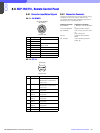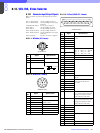
9
Chapter 9 Glossary – Terms and Definitions 173HDC-900/950/930 Series Product Information Manual
9-1. Hardware
The following are some technical terms that are
frequently used in camera brochures or technical
papers.
Adaptive DTL
A simple limiter makes DTL become thick. Adaptive
DTL is a very effective function to keep the DTL under
a certain level. It was originally developed for anti-
aliasing.
Adaptive highlight control
To make the picture look perceptively better -, the
picture is divided into several zones along the bright
level in which the compression rates of the smaller
zones are increased while those of the larger zones are
decreased. The Adaptive Highlight Control has been
developed for Sony’s HDC/BVP-Series, which only
applys to the portion whose level is higher than the
knee point.
Aspect ratio conversion
Converting 16:9 video signals to 4:3 signals is
essential because most of the applications today are
4:3 even though sometimes shot with 16:9 cameras.
Sony video cameras for broadcasting and professional
use provide the aspect ratio conversion function in
combination with a digital filter. Some manufacturers
perform this function by changing the reading process
of the CCD.
Auto knee/DCC
It is a device that automatically adjusts the knee point
and knee slope to raise the dynamic range depending
on the pattern of the subject for photography.
Black Gamma
Black Gamma is a function to change the Gamma
curve of dark portions of the picture. It also can change
the coloring.
Black shading correction
Black shading correction is used to compensate for
the irregular black shading which occurs because of
the dark current of picture elements and the
characteristics of power circuits.
Boost frequency
Horizontal image enhancement is usually performed
by raising the space frequency between 3 to 4 MHz.
The peak of the frequency raised can be adjusted in
order to meet the users’ different tastes.
CCD
CCD is the acronym for Charge Coupled Device. It is a
kind of semiconductor that converts an optical image
into electronic signals - the heart of a camera. After
accomplishing the conversion, each pixel (a kind of
photoelectric transformer) on the CCD first holds the
signal and then transfers it to the next cell. These cells
work like a bucket brigade. According to the transfer
method, there are two types of CCDs - IT CCD and FIT
CCD.
Color bars
Almost all of the video cameras used for broadcasting
- have a color bar generator. Although the color bar
has been originally developed for the adjustment of an
analog encoder, it has become a standard function for
professional video camera. Since video cameras are
quite often used as a color bar generator, it is still a
standard function for a video camera even though the
encoder has been digitalized.
Crisp
DTL enhances picture sharpness but at the same time
also emphasizes the noise, which makes the picture
noisy. Crisp is a circuit that removes small amplitude
DTL to improve S/N.
DTL comb filter
The DTL comb filter is used to weaken the oblique DTL
that interferes with the sub carrier to generate cross
color. However, resolution seems to look bad if the
oblique DTL becomes too weak. Some component-
dedicated cameras such as HD cameras do not adopt
DTL comb filter.
Electronic soft focus
The DTL circuit can make the picture sharper, but it
can also shade off the picture by reverting the polarity.
When used this way, electronic soft focus is a function
to generate a gentle film-like picture. It is more
effective to make an announcer’s skin color much
more lustrous when used in combination with the Skin
Tone DTL.
Encoder
Inside the camera, video signals are processed in R/G/
B component signals. The encoder is a device used to
convert the component signals into composite signals
such as NTSC and PAL.
Flare correction
In an optical system, the image might sometimes seem
floating or some colors might appear in dark portions
of the picture because of diffused reflection. Flare
correction electronically compensates for this
phenomenon.
Gamma correction
A CRT does not beam at the screen linearly as per the
signal level. Normally, a TV set should compensate for
the error because it is part of a CRT’s characteristics.
However, in consideration of the total cost, the industry
has reached an agreement with TV stations that the
acquisition side should take the responsibility to
correct the error. This is the gamma correction. As the
standard in this agreement is not very strict, the
Gamma correction value is not always completely the
same between different manufacturers and different
TV stations. In the camera field, Gamma correction is
also a way of creating user’s taste and setting the
picture quality.
Gen lock
Synchronization should be done when using multiple
cameras. Gen lock is a function developed for this
purpose to synchronize the cameras to an external
VBS input. Then, horizontal phase, vertical phase, and
sub-carrier phase will be synchronized.
Horizontal image enhancement (H DTL)
Horizontal image enhancement is performed by
raising the frequency characteristic of the video
signals which is carried out by using the Low Pass
Filter and Delay Line for analog cameras while using
the digital filter for digital cameras.
Image Enhancement
It is a function to give a perception of a sharper picture
or higher resolution. Since the characteristic cannot be


















